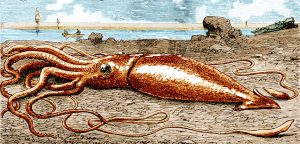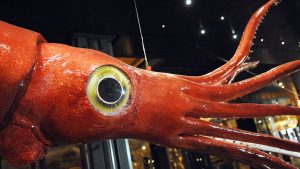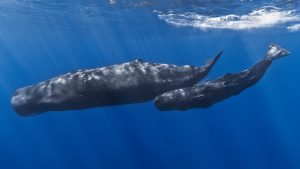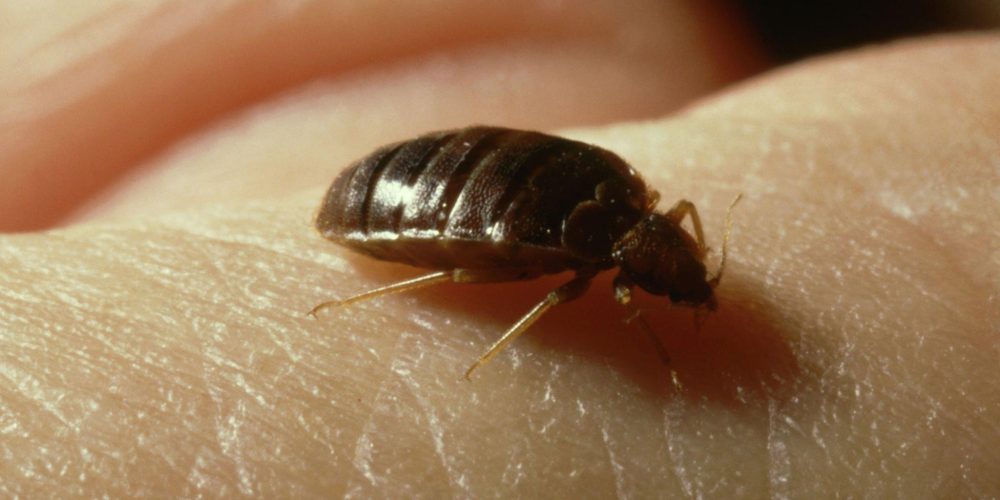The giant squid is one of the most magnificent creatures of our deep oceans. However, there is much that we still have to discover about this incredible and elusive animal. Also known as Architeuthis dux, this might be the world’s largest invertebrate. The giant squid belongs to the class of cephalopods, which have been around for 500 million years. For years non-scientists wondered if the creature actually existed or was just a thing of legend. People became suspicious of the fact that only dead ones were being captured, and some questioned if it was just a hoax. Very little is known about the lifestyle of the giant squid as it had evaded researchers for decades up until recently when the firth video footage was captured.
Unfortunately, most of what we know about the giant squid has only come from dead carcasses that have washed up on beaches. The most common shores they wash up on are in New Zealand and the Pacific Islands. It is believed that giant squid live in every ocean, but it remains difficult to confirm this fact due to their elusive nature. As large as this animal is, it remains difficult to find because it lives so deep in the ocean. They live in total darkness, about 500 meters to 1.5 km (1,600–5,000 feet) below the surface of the ocean.
Size and weight of giant squid
Scientists are unsure just how big these creatures are because it is hard to gain that from bloated or disintegrated dead carcasses when they wash ashore. Different sources give different lengths. On average, giant squid measure approximately 33 feet (or 10 meters) and weigh about 400 pounds (that’s about 180 kg). Some sources claim that the largest giant squid ever recorded was 43 feet (13 meters) in length.
However, other sources claim that the largest ever recorded giant squid, which washed ashore in 1887 in New Zealand, measured apparently 59 feet (or 18 meters) and weighed almost one ton. But it’s still debatable if these estimates are correct, and the two long feeding tentacles take up a huge chunk of the body length.
A newer method for determining size is by the giant squid’s beak, which is often left behind even after being eaten by a sperm whale. The same method is used to determine the size and age of colossal squid as well. Eight arms and two longer feeding tentacles help the giant squid to seize their prey and bring it to their mouths called beaks. This animal is capable of grabbing prey from far away with those tentacles, which are also equipped with many sharp-toothed suckers.
In June 2020, a giant squid washed up on shore in South Africa. This one is estimated to be around 4 meters (13 feet) long, which is actually pretty small for a giant squid. What makes this find exciting is that this giant squid only recently died and had not yet started decomposing. The only thing missing was its beak, which scientists believe fell off once the muscles relaxed at the time of death.
Largest eyes in the animal kingdom and very unique body
Scientists have not witnessed giant squid feeding, but they have been able to determine their diet by studying the stomachs of the specimens that have washed up on the world’s beaches. Giant squid are carnivores and tend to prey on smaller fish, shrimp, other squid, and possibly some whales. The mantle is the main part of the body, containing all of the basic organs. Their beak is sharp and made for ripping flesh into bite-size pieces. The beak is located in the middle of their arms.
The giant squid, along with their cousin, the colossal squid, have the biggest eyes in the entire animal kingdom. Their eyes measure about 30 cm (12 inches) in diameter, about as big as a dinner plate or a human head. This begs the question: If the giant squid lives so deep in the ocean where it is pitch black, why does it need such big eyes if there isn’t much to see? For one, it helps them to see sperm whales, their only known predators, from safe distances. Bioluminescence light is given off from small gelatinous animals when they are disturbed. A squid uses this light for survival purposes like spotting the impending danger of a diving sperm whale.
Another unique feature about the giant squid is that it has a rather complex brain, shaped like a doughnut, with the esophagus traveling right through the “donut hole.” It is also known that giant squid also have three hearts and pump blue blood. Scientists are still learning the functions behind these unique features. This animal can roam the deep ocean thanks to its small fins, which help them maneuver themselves through water and a funnel which is used as a jet propulsion system by siphoning water through their mantle, which is their head, and quickly releasing it out the back. This allows them a quick escape when needed. The funnel also allows the giant squid to exhale, lay eggs, excrete waste, and squirt ink for an escape from predators.
Lifespan and reproduction of giant squid
It is believed that the giant squid’s lifespan is about five years. Statoliths, which are small mineralized masses that help the squid balance themselves, acquire “growth rings” like a tree and help researchers estimate the age. This suggests that they grow at an unfathomable rate; reaching up to 10 meters (33 feet) in 2-3 few years.
In their fleeting lifespan, researchers believe that the giant squid only reproduces once. After the eggs have been fertilized by the male, the female releases the “egg mass,” endless amounts of tiny eggs covered in jelly, into the water. While many are eaten by predators, some survive and grow into the massive creatures that haunt the deep seas.
Sperm whale as the main natural predator
There is only one known predator to adult giant squid, and that is the sperm whale. Much like the colossal squid, beaks of giant squid have been found inside the carcasses of sperm whales. However, juveniles are often preyed upon by larger squids and sharks. According to National Geographic, although the current population trend is unknown, the giant squid is not an endangered species or in fear of going extinct. In fact, their Conservation Status is listed at Least Concern, meaning that there are more than enough to last a long time.
The mythological Kraken was said to lurk at the bottom of the ocean, waiting for a ship to pass by to prey upon the sailors. The creature resembles either a giant squid or a colossal squid. It would reach up and sink the ship with its massive tentacles or create a whirlpool to destroy the ship.
Is the giant squid dangerous to humans?
There is not much evidence to conclude the danger giant squid pose to humans. However, being a giant carnivore wild animal, one would assume that they could indeed pose a risk to humans. The lack of reports of giant squid attacks on humans (and boats) is probably because they mainly live in the deep sea and, therefore, very rarely encounter humans. The giant squid that swim up to the surface are also usually sick and weakened individuals. Giant squid have the potential to be harmful to humans in multiple ways.
Their beaks could do harm if they decided that you were a meal. But more than that, even their tentacles and suckers could cause harm if they came in contact with you just due to their force. So you should really avoid these giants. Chances are that you might get snapped and dragged down, never to be seen again.
In 2004, researchers recorded the first-ever images of an alive giant squid and in 2012, researchers filmed the animal in its natural habitat, and in 2019, another giant squid was filmed by NOAA off the coast of Louisiana.
While oceans cover about 70% of the earth’s surface, about 90-95% of our ocean is unmapped, unobserved, and unexplored. That leaves a lot of territory left to explore and discover. In the small portion of the waters that have been explored, scientists have been able to discover approximately one million species living in them. If the giant squid can evade researchers for centuries, what other mysterious and mesmerizing creatures lay waiting at the bottom of the ocean for our discovery? Only time can tell. And that is an exciting thought! What will be discovered tomorrow? Just when we think we’ve seen it all, something new gets discovered.

















